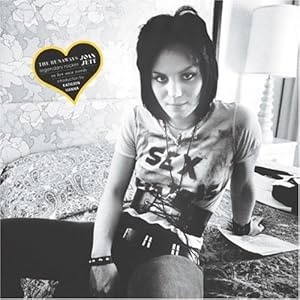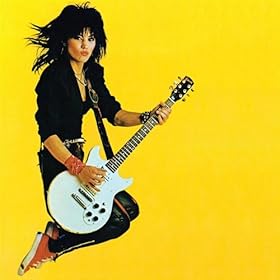 I consider myself a professional amateur, as it were: someone who can write clearly and concisely about the things that make me go “EEEE.” This makes me particularly suited to review Joan Jett (Ammo, 2010) by Todd Oldham.
I consider myself a professional amateur, as it were: someone who can write clearly and concisely about the things that make me go “EEEE.” This makes me particularly suited to review Joan Jett (Ammo, 2010) by Todd Oldham.
Oldham, of course, has made his name as a top fashion designer. But when it comes to rock music, he’s just a big fanboy — albeit one whose name is above the title of this book (which has an introduction by Riot Grrl Kathleen Hanna). Oldham conducted a series of interviews with the founder of the Blackhearts, and referred to many of the thousands of interviews Jett has given in the three-plus decades she’s been on the music scene. Of course he is familiar with her oeuvre and mythos because he is One of Us: a Jetthead. He first heard her music in 1976 when as a teenager in Tehran, Iran, he bought a bootleg tape of The Runaways.
The Runaways, Jett’s first band, have been brought front and center this spring with the release of the film The Runaways, directed by Floria Sigismondi, starring Kristen Stewart as Jett and Dakota Fanning as bandmate Cherie Currie. (The film is inspired by Currie’s memoir Neon Angel, which was expanded and released to coincide with the film).
While the film is fictionalized, eliding time and compiling several characters into one for the sake of dramatic tension, the creation myth retains some events in common: Jett, an extraordinarily determined teenager, helped found one of the first all-girl rock groups — and when that group plummeted to a fiery ending, she picked herself up and kept going to become the rockstar she always knew she wanted to be.
Oldham’s interviews track the story in roughly chronological order, with a couple of chapters focusing specifically on her videos, and her long-time business partner/best friend Kenny Laguna.
The Jettheads have this book already. What about the rest of you? While the text is delicious, what makes the book a beautiful treat to both look at and read are the photos: a documentary record in both B&W and color of iconic photos both staged and casual, from photo sessions for album covers to family snapshots. The book’s divided into 20 chapters, each letting Joan narrate a chapter in her own life. (To my mind, the most iconic shot of Jett is the cover of her album Album, showing the Blackheart clutching her guitar, hair flying, in mid-leap, against a bright yellow background.)
 Jett morphs over the years from punk/possibly drunk teenager/glam idol/ shag-haired leather queen to current-mother-hen-to-young rockers-who-can-still-kick-your-ass-if-she-wants-to over the course of the book. The baby pictures (which certain Jettheads of my acquaintance — who swear they have everything — don’t even have) are adorable, and early on, as the future Blackheart splashes in the tub with a duckie, don’t give any hint to the drive that lies under the surface.
Jett morphs over the years from punk/possibly drunk teenager/glam idol/ shag-haired leather queen to current-mother-hen-to-young rockers-who-can-still-kick-your-ass-if-she-wants-to over the course of the book. The baby pictures (which certain Jettheads of my acquaintance — who swear they have everything — don’t even have) are adorable, and early on, as the future Blackheart splashes in the tub with a duckie, don’t give any hint to the drive that lies under the surface.
Junior high photos show Joan, with her long brown/blonde hair parted in the middle, ’70s style, in a plaid dress, as an elementary schooler, holding a lunchbox, as just a little older than a toddler, posed thoughtfully, hands clasped in a white dress.
(This phase did not last long.)
Jett recalls how at 13 she got her first electric guitar, and soon after that was haunting the LA rock haunts, looking for something (or someone) to make her mark. She, Kari Krome, and Sandy West started the Runaways with producer/guru Kim Fowley (about whom many books could be written, most of them with a “parental warning” on the cover). About that time, Jett’s hair turns from blonde to black, and she’s never seen in a dress again: jeans and lather are her preferred uniform and mask.
A candid photo from after a Runaway show displays her crowded onto a sofa with the others, grinning, sweaty, her eyeliner running. There’s more than one photo of Jett giving the finger (or two), sometimes with a grin, sometimes with the hairy eyeball. There she is with glitter scenemaker/DJ Rodney Bingenheimer (subject of his own documentary, “Mayor of the Sunset Strip” a few years ago). There she is in London, with Sid Vicious, in the final days of the Runaways.
“I guess it had to be like it was, and it had to end how it did. And it had to go through its growing pains and be just what it was because anything else, it just wouldn’t have been The Runaways,” she says now of the group’s demise.
Enter Kenny Laguna, a sort of rock-and-roll Zelig, who’d been involved in scenes ranging from bubblegum to Motown; originally brought together to write songs for a contractually-obligated Runaways film (which went through many forms and became possibly the worst film ever made, Du-beat-e-o), Jett and Laguna hit it off, became partners and moved on to the next part of the creation folklore: Jett moved to New York, and became the Lagunas’ guest rockstar. She and Kenny founded Blackheart Records, raided Laguna’s daughter’s college fund for the cash, then sold thousands of the self-pressed Joan Jett albums (on vinyl!) out of the trunk of their car.
It’s also Blackheart legend how the first album was turned down by dozens of labels, and there’s a picture of a framed letter from a VP at A&M, who says “although I like the tunes and production, I didn’t feel strongly enough about her vocals to make a commitment at this time.” The picture is followed by another of a framed nomination for a Grammy Award (a sort of conceptual middle finger raised).
Enter the Blackhearts: Jett recalls the origins of her group, which has had many personnel changes of the years, but remains the same in structure: a lead guitar, Jett on rhythm, a bass player and drummer. We Jettheads can name most of them, including the temporary fill-ins, but you will not be tested on this.
The Blackhearts toured endlessly, wrote songs which were defining pop/punk nuggets, and made covers their own (including a song by The Arrows, called “I Love Rock and Roll”), and we see pictures of the hand-penned lyrics on legal paper. There’s an entire chapter on Jett’s guitars; as of this year, there’s a Gibson model named for her. Jett makes it clear that rhythm is her preference, and she works hard to fill her place in the section: “I really worked on learning my guitar, because people tend to overlook rhythm guitar a lot…I’m about the rhythm and keeping the song structure.”
Jett waxes poetic about the pull of the road, about constantly touring, and playing live. “There’s something about touring that’s really magical — a special love you have with your audience that nobody else can get into…It’s a real joyful sensation. You’re just full of happiness. You get chills….Everybody’s on the same wavelength. It’s like an overwhelming feeling of love, almost.”
In the last chapters, Jett discusses her views on Women in Rock, which can be an irritating issue because it’s still an issue in the music industry. “I think it has improved a lot for women in rock, although they do assume you’re not as good. It’s funny to watch people wake up. Like at a sound check or something…I’ll start ripping off some Chuck Berry-style something, an all the security people will look around like, ‘God, that came out of her guitar?'”
Yes, it did. And if you’re lucky, one day you might stand pressed up against the stage and hear the sound of Jett’s Les Paul through a Marshall stack, get sweated on, and even catch one of her guitar picks. Until then, this book is a warm and comforting reminder to go to the next concert.
Kathleen Warnock is a playwright and editor. Her interviews and reviews have previously appeared in ROCKRGRL, Bust, Metal Maidens, and other magazines. Her play, Rock the Line, was produced by Emerging Artists Theatre, won the Robert Chesley Award for Emerging Playwrights, and is published by United Stages.




Comments